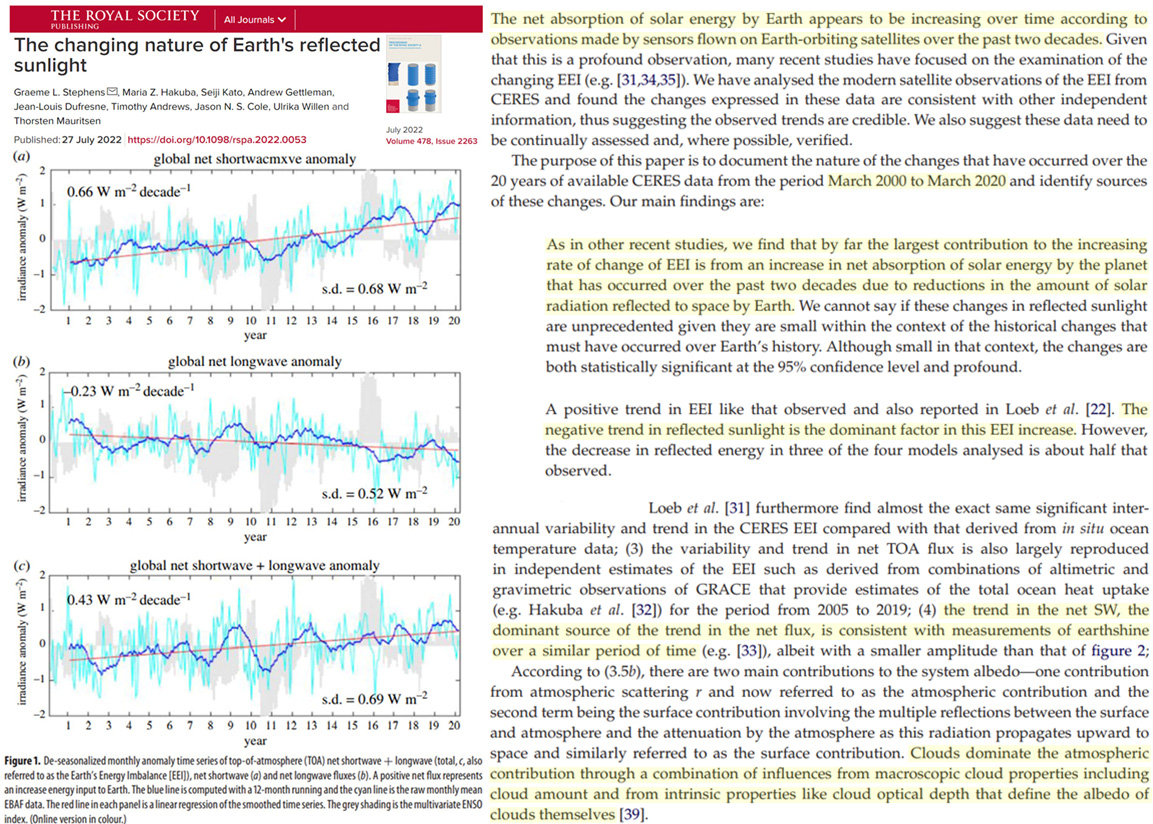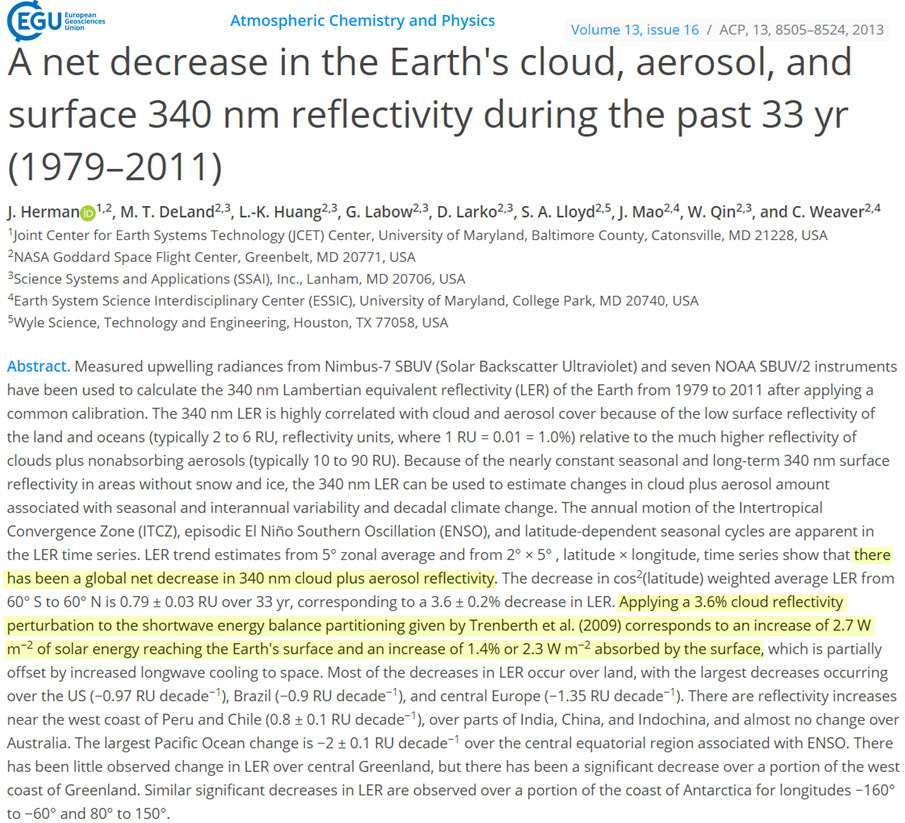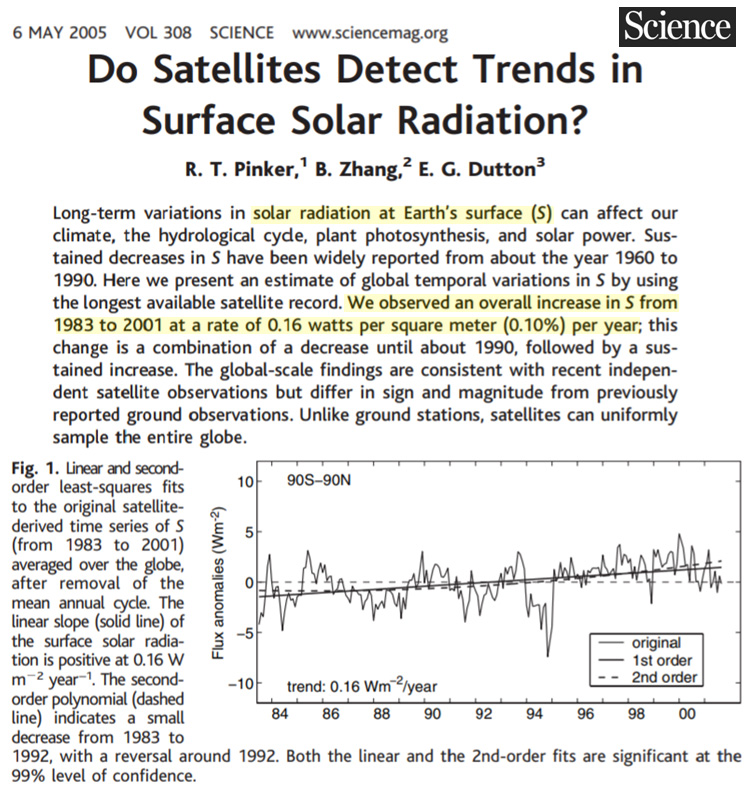Scientists have once again affirmed the 2000-2020 total greenhouse effect (longwave) forcing has been declining in recent decades just as absorbed solar radiation has been increasing due to cloud albedo modulation. The latter explains the net positive Earth Energy Imbalance (EEI) and consequent global warming during this period.
Recently we detailed the satellite-observed decline in total (“all sky”) greenhouse effect forcing since 1985 and the concomitant increase in surface solar radiation over the last 35 years.
Yet another scientific paper has been published affirming a -0.23 W/m² per decade−1 decline in total longwave forcing (the net impact due to changes in greenhouse gases and cloud cover) and a +0.66 W/m² per decade−1 (+1.3 W/m²) increase in absorbed solar radiation during the 21st century (March 2000 to March 2020).
The net absorption of solar energy that has occurred due to the reduction of solar radiation reflected to space by clouds and aerosols is “by far the largest contribution to the increasing rate of change of EEI.” In other words, the impact of CO2 and other greenhouse gas forcing together with cloud has contributed a net cooling influence that has been soundly superseded by the increasing solar radiation trend.

Image Source: Stephens et al., 2022
The increasing trend in absorbed surface solar radiation has been observed over the entire satellite period – not just since 2000.
Herman et al. (2013) documented a +2.7 W/m² in solar energy due to the declining cloud and aerosol albedo trend from 1979-2011.

Image Source: Herman et al., 2013
Pinker et al. (2005) reported a +1.6 W/m² per decade−1 trend in global surface solar radiation from 1983 to 2001.

Image Source: Pinker et al., 2005
The global warming that has occurred since the 1980s can be fully explained by the increasing trend in solar radiation and not the (net decreasing) greenhouse effect forcing trend. These observations undermine the claims of proponents of anthropogenic global warming.





The “Climate Cult” ignored many of the cautions put forth by Richard Feynman, such as eliminating alternative explanations, and you, the researcher, are the easiest person to fool.
K.R.,
Willie Soon uses one of your posts in his recent talk; available on WUWT.
But we’re still doomed, aren’t we?
Yeah, we’re still doomed and for exactly the same reason we’ve been doomed by the other C-word since Jan 2020: not by the purported phenomenon or by actual phenomenon behind someone’s explanation of it, but by the things done by the respective groups using their interpretation (scare stories) to justify those actions. And if you were to draw a Venn diagram of the adherents of those two groups, you would find an overlap of at least 97%, the same as you would for every other environmental/health/technology scare since at least the 1950s.
All of this is well and good, but ignores the effect of the ultraviolet component of the sun’s rays which varies strongly with solar activity. UV penetrates the ocean to a depth of hundreds of feet so that the energy is stored in the ocean and not reflected to space. When this is finally realized we can go on to the next enviro scare.
It also ignores particle energy from the solar wind and CMEs not to mention magnetic fields that connect the sun and planets.
I wonder if the effect of the reduction in aerosols in the atmosphere has been underestimated. Consider the fact that since the 1950s, most industrial countries have reduced or eliminated the use of coal for heating and transportation, and drastically reduced the particulate emissions from diesel engines. Industrial processes typically release much lower levels today than in past decades. Where I live, smog days are rare now, and I almost never see the brown atmospheric haze that used to be a common sight in cities, especially looking towards the horizon in the summer. Local weather reports have stopped routinely including an air pollution index value, only issuing alerts in unusual circumstances.
A clearer atmosphere equals increased surface insolation.
Thanks for another excellent post Kenneth.
Another recent paper, Yuan et al. 2021, confirms the increase in Surface Solar Radiation since 1975, and also a steep fall from 1960 to 1975 during the global cooling scare. Rather than satellites, this data comes from ground stations around the world.
It’s linked and analysed in this post at the Talkshop:
https://tallbloke.wordpress.com/2022/07/11/ned-nikolov-does-a-surface-solar-radiation-dataset-expose-a-major-manipulation-of-global-temperature-records/
Europe clouds and sunshine duration:
https://climate.copernicus.eu/esotc/2020/clouds-and-sunshine-duration
“In other words, the impact of CO2 and other greenhouse gas forcing together with cloud has contributed a net cooling influence that has been soundly superseded by the increasing solar radiation trend.”
So where is my global warming???
Interesting you should post this.
Here’s the reality, We are entering a grand solar minimum which will peak around 2030 – the Parasites that be know this, and anyone who has been paying attention has noticed the rapid decline in growing season length, and extreme temperatures high and low.
Lower solar output = less evaporation = less atmospheric water vapor = extreme temperatures. Condensation heats and evaporation cools – a nice negative feedback loop allowing life. The atmospheric water vapor is already decreasing rapidly, (don’t ask how I know this) and the loss of half of all trees in the sierras (a dead tree wasteland) – and large part of rainforest, isn’t helping.
Anyone with a functioning mind knows covid was a hoax but producting a viral antigen in your own cells can and will kill via autoimmunity. The global warming / climate change hoax is a big moneymaker on wall street – how easy it is when you write laws and the next step toward Bolshevism worldwide – a prison planet – it’s how they are responding to a 60 year ice age perhaps longer.
This is slightly related:
https://forces-project.eu/forces-policy-brief-released/
Cover Journal of Climate
Journal of Climate
Volume 34: Issue 23
Global Trends in Downward Surface Solar Radiation from Spatial Interpolated Ground Observations during 1961–2019
Menghan Yuan1, Thomas Leirvik1, and Martin Wild2
4. Discussion
This study interpolates a ground-based solar radiation observation dataset and constructs a dataset with complete global land coverage at high resolution covering nearly six decades. This enables a temporal and spatial trend analysis at the continental and the regional level, making it possible to obtain a comprehensive quantification of the long-term trends for the data-scarce continents (e.g., Africa and South America). Rather than relying principally on qualitative graphic visualization, a structural breakpoint detection algorithm based on moving sums (MOSUMS test) is applied and provides quantitative identification of any structural changes in the long-term SSR anomalies.
The results show that the global dimming–brightening transition takes place around 1982 on a global average level, which is in line with existing literature based on station observations.
The two divided segments show a decrease over 1961–81 and an increase over 1982–2019 at −3.07 and +0.33 W m−2 decade−1, respectively. We further examined SSR trends on a continental scale. We found that the largest contributors to the global dimming are Asia and North America, while the two most important drivers for global brightening are Europe and Oceania.
SOURCE:
https://journals.ametsoc.org/configurable/content/journals$002fclim$002f34$002f23$002fJCLI-D-21-0165.1.xml?t:ac=journals%24002fclim%24002f34%24002f23%24002fJCLI-D-21-0165.1.xml
The average solar irradiance over the past three decades is = 1361 W/m−2 (Prša et al., 2016). Per the quoted study, a change of +0.33 W m−2 decade from 1982 to 2019, or 3.7 decades, would be +1.22 W m-2. +1.22 W m-2 is irrelevant.
[…] New Study: A Post-2000 Increase In Absorbed Solar Energy ‘By Far The Largest Contribution̵… […]